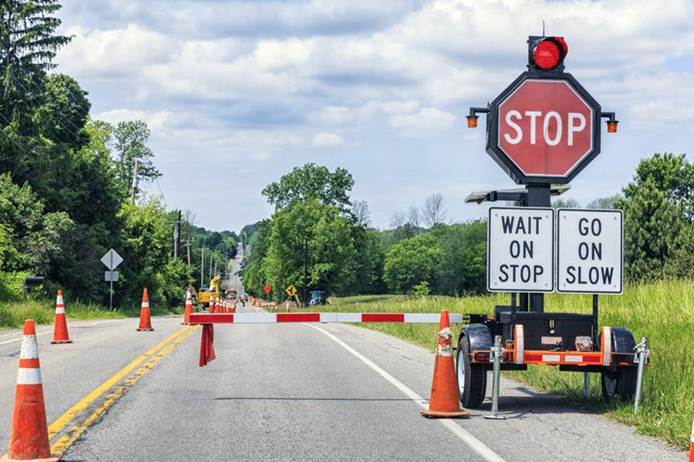
The Role of Construction Zones in Rochester Traffic Accidents
Construction zones are temporary, but the dangers they create are real and lasting. When roads are narrowed, lanes are shifted, or traffic is slowed without warning, drivers can find themselves in sudden and unsafe situations. In these spaces, even one wrong move—braking too late, missing a sign, or changing lanes too quickly—can cause a chain reaction.
Here in Rochester and throughout Monroe County, road construction is a part of daily life. Whether it's bridge repairs near the Inner Loop or repaving work along Route 104, these zones shape how we drive and where accidents happen.

Work-Zone Accidents: National and State Trends
Across the country, work zones continue to be a serious safety concern. According to data from WorkZoneSafety.org, there were over 700 fatal crashes in work zones in 2022 alone. Thousands more resulted in serious injuries. These aren't rare events—they happen every single day on highways, city streets, and rural roads.
In New York State, rear-end collisions make up the majority of work zone crashes. NYSDOT reports that these types of crashes often happen because drivers don’t anticipate how quickly traffic slows down. The severity can range, but even minor fender benders can turn dangerous when construction workers are nearby or when visibility is low.
To combat this, New York launched an automated work zone speed enforcement program. Speed cameras in certain areas now issue tickets to those who drive too fast through designated zones. The goal is simple: slow drivers down and reduce the number of injuries and deaths in these high-risk areas.
Local Context: Construction in Monroe County and Rochester
Monroe County is constantly updating its infrastructure. From bridge upgrades on East Ridge Road to pavement rehabilitation along Jefferson Road, the Monroe County Department of Transportation (MCDOT) maintains a long list of ongoing and upcoming projects. These projects often span weeks or even months, significantly impacting how traffic flows through Rochester neighborhoods.
Recognizing the safety risks involved, the county has also invested in better tools to track where crashes are happening. With help from the Federal Highway Administration, Monroe County upgraded its crash and traffic volume database. This allows planners to spot dangerous intersections or corridors—especially near work zones—more quickly.
Still, there are gaps. Local groups like the Genesee Transportation Council note that data on smaller roads is often missing or incomplete. That means crashes in residential areas or side streets may not get the attention they deserve when safety improvements are being planned.
How Construction Zones Elevate Accident Risk
Disturbed Traffic Flow and Lane Shifts
Lane shifts are one of the most disorienting changes in any construction zone. A familiar path becomes an unfamiliar maze. Drivers must suddenly merge, often without a full view of what’s ahead.
When cones and barrels guide cars into tighter lanes, side-swipe crashes and merging conflicts increase. Even a moment of hesitation can lead to a crash, especially during rush hour or poor weather.
Rear-End Collisions and Queuing Crashes
In Rochester’s work zones, rear-end crashes are especially common. One driver slows for a lane shift or flagger, and the car behind doesn’t react in time.
These crashes often occur because:
- Traffic slows suddenly in narrow areas
- Drivers are distracted or following too closely
- Warning signs are placed too close to the actual hazard
Some construction zones along I-490 have seen queuing backups that stretch for miles. If drivers aren't expecting a slowdown, they may not react quickly enough to avoid a collision.
Reduced Visibility and Signage Issues
Construction equipment, temporary barriers, and poorly placed signage can all block a driver's line of sight. When visibility drops—especially at night or in foggy weather—so does reaction time.
Nighttime work zones are especially risky. Inadequate lighting or faded lane markings make it harder for drivers to judge distances. If signs aren’t reflective or placed too low, they may go unnoticed until it’s too late.
Speed Differentials and Non-Compliance
Some drivers simply don’t slow down. Whether it’s impatience or distraction, driving through a work zone at full speed creates huge risks. When one vehicle moves through carefully and another barrels through at 15 or 20 mph faster, the chance of a crash rises sharply.
Speed differentials in work zones are a major contributor to side-swipes and rear-end collisions. Even if one driver is doing everything right, they can still get hit by someone who failed to adjust in time. If you’re injured because of someone else’s negligent actions, contacting an injury lawyer in Rochester should be your first step.
Interaction with Pedestrians, Cyclists, and Workers
In Rochester’s city streets, construction zones often push cyclists and pedestrians into tighter spaces alongside moving traffic. Crosswalks may be temporarily closed, sidewalks blocked, or bike lanes rerouted with little warning.
Meanwhile, construction workers themselves are constantly at risk. NYSDOT data shows a concerning number of crashes involve workers on foot—struck while crossing the work zone or standing near active lanes.
Case Examples / Hotspots (Rochester Area)
According to the Reconnect Rochester Crash Map, certain stretches of the city show a concerning overlap between active construction and crash clusters. Areas around Mount Hope Avenue, East Main Street, and portions of Lyell Avenue have all seen elevated crash rates during active road work periods.
For example, during recent sewer work on Clifford Avenue, the road was narrowed to one lane in each direction. Over a six-week period, crash reports doubled compared to the same stretch before construction began. Many involved side-swipes and rear-end impacts during lane changes.
Other construction-heavy corridors like West Henrietta Road near MCC have seen increased accident reports, especially during morning and evening commute hours when traffic volume peaks.
Mitigation Strategies and Best Practices
Advance Warning and Signage
Good signage starts well before the work zone begins. Drivers need time to understand what’s coming and prepare for changes.
Effective approaches include:
- Changeable message boards that alert drivers in real-time
- Brightly colored signs placed at intervals
- Flaggers guiding vehicles through complex merges
Clear lane markings and advanced notice help drivers stay calm and make safer decisions.
Speed Management and Enforcement
Lower speed limits in work zones only help if drivers follow them. Enforcement—either by police patrol or automated speed cameras—is essential.
Some work zones in Rochester now include:
- Speed feedback signs that flash when drivers are going too fast
- Rumble strips that create noise and vibration to alert distracted drivers
These tools remind drivers to slow down and pay attention before they reach the most dangerous parts of the zone.
Channelization and Physical Barriers
Cones, barrels, and barriers don’t just guide traffic—they protect people. When used correctly, they create a visual path and separate moving vehicles from active work.
Buffer zones give an extra layer of safety. In Rochester, this is especially important on busy roads like Lake Avenue or West Main, where traffic speeds can remain high even near construction.
Nighttime and Low-Light Adaptations
Visibility matters. Better lighting, high-visibility signage, and reflective materials make work zones safer for everyone.
Some Rochester work crews now avoid high-risk maneuvers like lane closures during nighttime hours. Instead, they schedule those activities during mid-morning lulls when traffic is lighter.
Worker Safety Protocols
Keeping workers safe starts with proper training. Crews need to understand traffic flow and be aware of blind spots around equipment.
Other important protocols:
- Create clearly marked safe zones within the site
- Schedule hazardous tasks when traffic is low
- Use spotters to assist near moving machinery
Monitoring and Data-Informed Adjustments
Monitoring crash reports and near-miss incidents helps improve safety over time. By tracking what goes wrong, agencies can adapt future work zones to prevent repeat problems.
Using real-time data, city planners can spot bottlenecks or confusing signage and make quick adjustments—even mid-project.
Challenges and Gaps in Rochester / Monroe County
Not all roads get equal attention. Smaller side streets and local residential roads often lack good traffic data. Without it, safety planners can’t always spot where trouble is building.
Other challenges include:
- Budget limitations for adding extra signage or enforcement
- Pressure to finish projects quickly, sometimes at the cost of ideal safety designs
- Limited police resources to patrol all work zones consistently
- Inconsistent driver behavior and resistance to lower speeds
These gaps make it harder to prevent accidents in certain parts of Monroe County.
What Drivers and Road Users Can Do
While agencies can improve design and enforcement, drivers also play a key role in making work zones safer.
Here’s what you can do:
- Stay alert and scan ahead for lane shifts or slowing traffic
- Begin slowing down before signs tell you to
- Keep a safe following distance, especially in stop-and-go conditions
- Watch for workers and equipment, especially near curbs and medians
- Avoid distractions—put the phone away and turn down loud music
- Use alternate routes when major construction is active
Even small adjustments in your habits can prevent serious accidents.
Future Outlook and Recommendations
Looking forward, Rochester and Monroe County could benefit from more real-time monitoring tools in work zones. Smart cameras, traffic sensors, and mobile alerts can help drivers and planners alike respond to problems faster.
Other useful steps include:
- Expanding New York’s automated speed enforcement program to more roads
- Encouraging local residents to report unsafe conditions or poor signage
- Closing data gaps on minor roads to help pinpoint where crashes happen most
The goal should always be the same: fewer crashes, safer roads, and better protection for both drivers and workers.
Construction Zones Are Everywhere
Construction zones in Rochester and Monroe County may be temporary, but the risks they bring are real. These areas disrupt traffic, limit visibility, and demand a higher level of attention from everyone behind the wheel. Crashes in these zones aren’t just statistics, they’re real people hurt in real situations that could have been avoided with better planning, clearer signage, and safer behavior.

What Sets Us Apart From The Rest?
Horn Wright, LLP is here to help you get the results you need with a team you can trust.
-
Client-Focused ApproachWe’re a client-centered, results-oriented firm. When you work with us, you can have confidence we’ll put your best interests at the forefront of your case – it’s that simple.
-
Creative & Innovative Solutions
No two cases are the same, and neither are their solutions. Our attorneys provide creative points of view to yield exemplary results.
-
Experienced Attorneys
We have a team of trusted and respected attorneys to ensure your case is matched with the best attorney possible.
-
Driven By Justice
The core of our legal practice is our commitment to obtaining justice for those who have been wronged and need a powerful voice.

